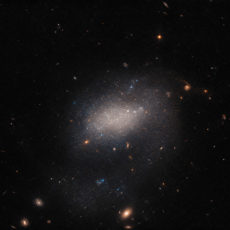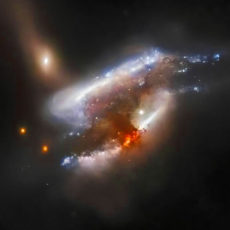
Some 46 million light-years away in the constellation Leo, a spiral galaxy named NGC 3507 spins through the cosmos, its arms stretching like a celestial pinwheel caught in an eternal twirl. Captured in stunning detail by the NASA/ESA Hubble Space Telescope, this galaxy isn’t just a pretty face in the universe—it’s a dynamic powerhouse of star formation and gravitational artistry.

NGC 3507 is a barred spiral galaxy, a classification that immediately sets it apart from the classic spiral shapes you might picture. Its defining feature? A glowing central bar of stars that slices through its core, with sweeping spiral arms unfurling from either end. “The bar is like a cosmic traffic director,” says Dr. Emma Chapman, an astrophysicist at Imperial College London. “It funnels gas and dust toward the galaxy’s center, sparking bursts of star formation.” This bar, visible in Hubble’s crisp imagery, isn’t just a structural quirk—it’s a key player in the galaxy’s evolution, channeling material at speeds of 50–100 kilometers per second, as noted in recent studies.
- LEGO NASA Space Set - This adult LEGO set features the Space Shuttle Discovery and the Hubble Space Telescope from NASA’s 1990 STS-31 mission,...
- Solar System Exploration - Unlock the mysteries of our solar system with this engaging 2,354-piece project, packed with authentic details and...
- Shuttle Features Galore - The space shuttle model has an opening payload bay, retractable landing gear, opening cockpit, moving elevons, space arm,...
What sets NGC 3507 apart from its cosmic peers is its partnership with NGC 3501, a neighboring galaxy just outside Hubble’s frame in this image. The two are gravitationally bound, locked in a slow, cosmic dance that shapes their structures. “Galactic pairs like this are fascinating because their interactions can stretch and distort their shapes,” explains Dr. Brad Frank, a researcher at the Space Telescope Science Institute. “NGC 3507’s elongated arms might be a result of NGC 3501’s gravitational tug, pulling and twisting its spiral structure over millions of years.”
Hubble’s Wide Field Camera 3, used to capture this image, reveals NGC 3507 in a kaleidoscope of colors, thanks to multiple filters that catch everything from ultraviolet to infrared light. These filters highlight details invisible to the human eye, like the wispy gas clouds and dark dust lanes weaving through the galaxy. “The variety of wavelengths lets us dissect the galaxy’s components,” says Dr. Linda Tacconi of the Max Planck Institute for Extraterrestrial Physics. “We can see where stars are born, where dust obscures light, and how gas flows through the system.”
Barred spirals like NGC 3507 are surprisingly common, making up about 60% of all galaxies, according to astronomers. The bar itself is a sign of a galaxy hitting its stride, a structure that often forms as a galaxy matures. “Bars are like a galaxy’s midlife crisis,” quips Dr. Chapman. “They show up when the galaxy has enough mass and momentum to reorganize its stars and gas into these dense, linear structures.” But bars aren’t permanent. Over time, the mass they accumulate can destabilize, potentially dissolving or reshaping the galaxy.















